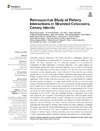Identificador persistente para citar o vincular este elemento:
https://accedacris.ulpgc.es/jspui/handle/10553/75691
| Título: | Retrospective study of fishery interactions in stranded cetaceans, Canary Islands | Autores/as: | Puig Lozano, Raquel Fernández Rodríguez, Antonio Jesús Sierra Pulpillo, Eva María Saavedra Santana, Pedro Suarez Santana, Cristian Manuel De La Fuente Marquez, Jesus Díaz-Delgado, Josué Alves Godinho,Ana García Álvarez, Natalia Succa, Daniele Xuriach, Aina Arregui Gil, Marina Felipe Jiménez, Idaira Del Carmen Consoli, Francesco Díaz Santana, Pablo José Segura Göthlin, Simone Câmara, Nakita Rivero Santana, Miguel Antonio Sacchini, Simona Bernaldo De Quirós Miranda, Yara Arbelo Hernández, Manuel Antonio |
Clasificación UNESCO: | 240119 Zoología marina 310907 Patología |
Palabras clave: | Atlantic Spotted Dolphin Bryde'S Whale Bycatch Entanglement Fisherman Aggressions, et al. |
Fecha de publicación: | 2020 | Publicación seriada: | Frontiers in Veterinary Science | Resumen: | Estimating cetacean interactions with fishery activities is challenging. Bycatch and chronic entanglements are responsible for thousands of cetacean deaths per year globally. This study represents the first systematic approach to the postmortem investigation of fishery interactions in stranded cetaceans in the Canary Islands. We retrospectively studied 586 cases necropsied between January 2000 and December 2018. Of the cases with a known cause of death, 7.4% (32/453) were due to fishery interactions, and the Atlantic spotted dolphin (Stenella frontalis) was the most affected species [46.9% (15/32)]. Three types of fishery interactions were recognized by gross findings: bycatch [65.6% (21/32)], chronic entanglements [18.8% (6/32)], and fishermen aggression [15.6% (5/32)]. Among the bycaught cases, we differentiated the dolphins that died because of ingestion of longline hooks [23.8% (5/21)] from those that died because of fishing net entrapments [76.2% (16/21)], including dolphins that presumably died at depth due to peracute underwater entrapment (PUE) [37.5% (6/16)], dolphins that were hauled out alive and suffered additional trauma during handling [43.8% (7/16)], and those that were released alive but became stranded and died because of fishery interactions [18.7% (3/16)]. Gross and histologic findings of animals in each group were presented and compared. The histological approach confirmed gross lesions and excluded other possible causes of death. Cetaceans in good-fair body condition and shallow diving species were significantly more affected by fishery interactions, in agreement with the literature. Low rates of fishery interactions have been described, compared with other regions. However, within the last few years, sightings of entangled live whales, especially the minke whale (Balaenoptera acutorostrata) and Bryde's whale (B. edeni), have increased. This study contributes to further improvement of the evaluation of different types of fishery interactions and may facilitate the enforcement of future conservation policies to preserve cetacean populations in the Canary Islands. | URI: | https://accedacris.ulpgc.es/handle/10553/75691 | DOI: | 10.3389/fvets.2020.567258 | Fuente: | Frontiers in Veterinary Science [EISSN 2297-1769], v. 7, (Octubre 2020) |
| Colección: | Artículos |
Citas SCOPUSTM
19
actualizado el 08-jun-2025
Citas de WEB OF SCIENCETM
Citations
15
actualizado el 08-jun-2025
Visitas
213
actualizado el 03-feb-2024
Descargas
131
actualizado el 03-feb-2024
Google ScholarTM
Verifica
Altmetric
Comparte
Exporta metadatos
Los elementos en ULPGC accedaCRIS están protegidos por derechos de autor con todos los derechos reservados, a menos que se indique lo contrario.
